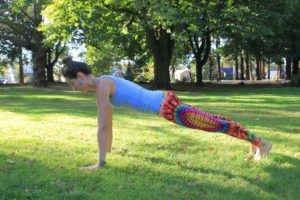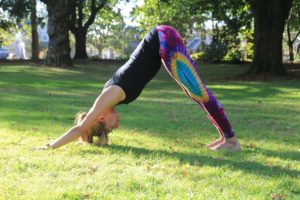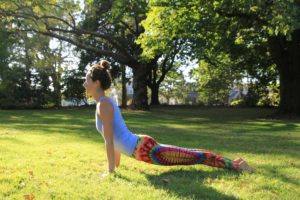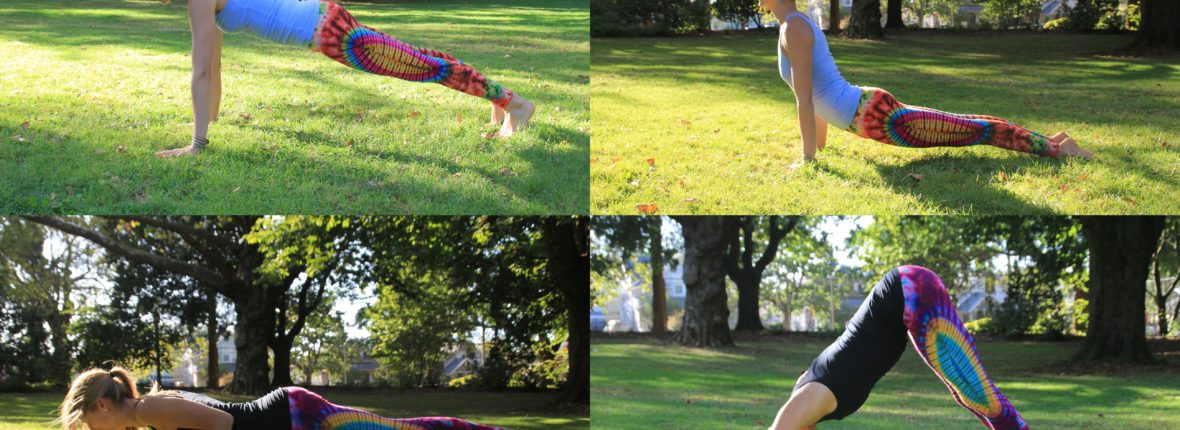According to Bernie Clark, yin yoga teacher, anatomy enthusiast, and author of Your Body, Your Yoga, yoga is a self-selecting practice. In other words, yoga attracts and keeps those students who can perform the poses that are commonly taught. In more depressing words, yoga repels and alienates those who cannot perform these poses.
I am a vinyasa yoga teacher. I began as a power vinyasa teacher. I am fully aware of the stigmas that often surround power vinyasa and vinyasa classes. I have read articles on the dangers of chaturanga, heard both students and friends tell me that they “just can’t do vinyasa classes anymore – they’re too hard on the body!”; I have even wondered, in my darkest hours, if I should trade vinyasa for hatha, yin, and restorative, exclusively, in interest of preventing my students from possibly injuring themselves. But there’s just one problem: I love vinyasa. It is my favorite kind of yoga to practice, and as a result, the kind of yoga I am most passionate about teaching. Each time I wonder if I should move toward something slower-paced, something less movement-oriented, something more yin and less yang, I hear my inner voice say, “But vinyasa feels so great! You love vinyasa, and so do plenty of other people!!”

Do some people get injured in vinyasa classes? Sure. Have I injured myself in vinyasa classes? Certainly. Is it yoga’s fault? Certainly not. When I have injured myself, it has been for one of two reasons: 1. I took a pose too far; I overstretched or overstrained and pulled or yanked something in an ungodly fashion. 2. I knew I was not comfortable, knew that my body could not or should not do a certain thing, but I did not know how to modify; I tried it anyway, and immediately regretted it. Vinyasa is indeed a tricky beast, as there is generally an expectation that class will keep on moving. Occasionally, I will pause class in order to demonstrate a certain thing, but generally, I try to keep the poses and transitions fluid. That is, after all, one of the great beauties of vinyasa: your body moves so your brain doesn’t have to.
 But what about those poses that are more difficult? What about those poses that we do so often that we stop thinking about them altogether? And what if, one day, we have aching wrists, if our arms get tired, our shoulders are unstable, or our hamstrings are tight?? In these cases, that great beauty of vinyasa – its movement – can become its greatest challenge, its greatest danger. In these cases we must, in fact, slow down in order to approach this movement safely. Sometimes, we must even stop.
But what about those poses that are more difficult? What about those poses that we do so often that we stop thinking about them altogether? And what if, one day, we have aching wrists, if our arms get tired, our shoulders are unstable, or our hamstrings are tight?? In these cases, that great beauty of vinyasa – its movement – can become its greatest challenge, its greatest danger. In these cases we must, in fact, slow down in order to approach this movement safely. Sometimes, we must even stop.
On Saturday, January 28, we will take this time. From 2-4 PM, Dr. Kara Giaier and I, Abby Kraai, will take you through the anatomy and alignment of the four most commonly taught poses and transitions in vinyasa yoga classes: plank, chaturanga, updog, downdog. In addition to helping you fine-tune your own alignment, we will highlight these poses’ essential elements, discuss common injuries and how to avoid them, and offer several modifications and variations for each. Then, from 4:30-6:30 PM, we will offer you the opportunity to integrate what you’ve learned through a two-hour vinyasa practice. We will play with variety in pacing, transitions, and sequences (don’t worry – you won’t just be doing planks, chaturangas, up-dogs and down-dogs for two hours!!).

If you already love vinyasa classes, this workshop is for you. If you want to gain confidence before trying a vinyasa class, this workshop is for you. If you love movement and want to learn more about it, this workshop is for you. Yoga may be a self-selecting practice, but it is our hope that through equipping our students with more knowledge of yoga and their own bodies, the yoga studio will become a more diverse and inclusive selection of people.

